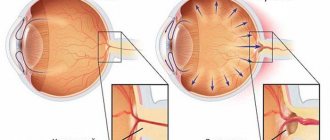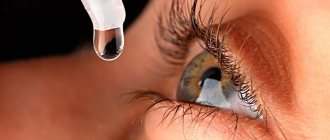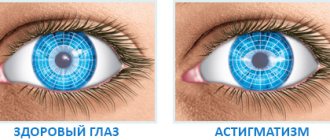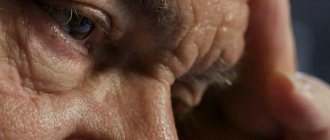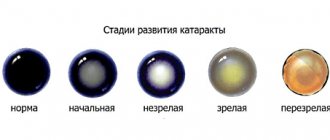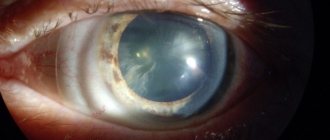Why do cataracts and glaucoma occur?
Cataract is an irreversible clouding of the lens and capsule. Often the disease is a consequence of the aging of the body. The following pathologies that provoke cataracts are also significant:
- metabolic disorders;
- diabetes.
The chemical composition in the tissues of the lens changes as natural aging occurs, which is accompanied by the formation of free radicals. They lead to the accumulation of toxic compounds.
Over time, the eye's antioxidant protection weakens. This increases the risk of developing cataracts. Gradually, adverse effects on the tissues of toxins are observed. Irreversible changes occur in the lens of the eye. If treatment, which also includes taking vitamins, is not started promptly, cataracts may occur. Pathology significantly worsens the quality of life.
The causes of cataracts include:
- unfavorable heredity;
- deformation of the lens due to injury;
- pathologies of the endocrine system;
- eye diseases (glaucoma, myopia);
- severe infectious processes;
- Down syndrome;
- burns of the organs of vision;
- eczema, neurodermatitis and other skin diseases;
- prolonged insolation;
- long-term corticosteroid therapy;
- exposure to radiation;
- unfavorable environmental conditions;
- poisoning with heavy metals and toxic substances;
- bad habits (excessive consumption of alcoholic beverages, smoking);
- insufficient sleep.
Sometimes cataracts are congenital. Pathology occurs as a result of previous diseases, which include rubella. Lens abnormality and cataracts may develop if a pregnant woman takes certain medications or has been exposed to radiation.
Attention! Symptoms of cataracts include double vision, blurred vision, increased sensitivity to light, the appearance of a non-existent halo around the light source, impaired color vision, and a feeling of haze.
Glaucoma causes increased pressure in the eyes, which leads to atrophy of the optic nerve. The pathology can progress asymptomatically for a long time. Often, a visit to a doctor is noted when there is a loss of visual acuity.
Glaucoma is considered a dangerous disease that causes blindness if left untreated. Timely therapy can stop the process of optic nerve atrophy. It is not possible to cure the disease completely.
In most cases, glaucoma is bilateral and is associated with a genetic predisposition. If there is a family history, intraocular pressure should be constantly monitored.
Increased pressure in the eyes and the development of cataracts are accompanied by the following symptoms:
- blurred vision;
- narrowing of fields;
- severe pain.
The reasons for the development of glaucoma are due to its varieties:
- congenital;
- secondary;
- open angle;
- closed angle.
Typically, an increase in pressure is associated with a violation of the drainage system of the eyes, leading to a change in the outflow of chamber fluid. Atrophy is caused by stress on the optic nerve. Among the factors that provoke glaucoma are:
- cervical osteochondrosis;
- sclerotic changes in blood vessels;
- lowering blood pressure.
These factors cause insufficient blood supply to the brain. Gradually, visual functions are impaired due to changes in metabolism in the tissues of the optic nerve and eye, and cataracts and glaucoma develop.
Eye drops for glaucoma and cataracts
Cataracts and glaucoma are diseases that threaten vision loss. If treatment is not started promptly, vision deteriorates quickly.
Rapid loss of visual perception is possible, and it can be problematic to restore it even if treatment is started.
Are there universal drugs for glaucoma and cataracts?
Universal drugs against cataracts and glaucoma include Timolol and Pilocarpine. Timolol reduces the production of intraocular fluid, and Pilocarpine additionally helps to lower the pressure inside the eye.
Fotil Forte drops have more of the active substance pilocarpine. The dosage of this remedy depends on each individual case.
For glaucoma or cataracts, drops are prescribed to dilate the pupil. They are used for diagnostic purposes and to eliminate accommodation spasms. These include Tropicamide, Midriacil, Irifrin. Drops 999 are also used for other eye pathologies.
If these remedies are used in the initial stages of the disease, then complete recovery is possible. They help cleanse blood vessels and tear ducts. The drug is ineffective if cataracts are a consequence of the diabetic process.
Drops for glaucoma
Glaucoma requires complex use of medications. They should block the formation of large amounts of fluid and reduce eye pressure.
Protection against coronavirus
How to boost immunity and protect loved ones
>
Arutimol
The drug in the form of eye drops is prescribed to regulate intraocular pressure in ophthalmic pathologies, incl. for glaucoma. The active component of Arutimol is timolol. Refers to non-selective β-1 and β-2 adrenergic blockers. Capable of reducing eye pressure in all categories of patients.
The active substance of the drug inhibits the system of transition of sodium ions from the blood into the intraocular space. As a result, intraocular pressure drops.
//www.youtube.com/watch?v=iqk_UgX-LVE
The therapeutic effect from the use of drops develops 20 minutes after instillation into the eyes. The maximum effect is observed after 2 hours and lasts almost the whole day. Long-term use of Arutimol significantly improves the process of outflow of moisture from the eye. Partially absorbed into the local bloodstream.
Can cause the following undesirable effects:
- visual impairment;
- dry eye syndrome (xerophthalmos);
- increased production of tear fluid;
- bronchospasm (in patients with asthma);
- arrhythmia (in the form of tachycardia or bradycardia);
- atrioventricular block;
- a sharp drop in blood pressure.
You need to instill this remedy 1 drop 2 times a day.
Dorzolamide
The drug is used for primary open-angle glaucoma. Considered a carbonic anhydrase inhibitor. Carbonic anhydrase is an enzyme present in trace amounts in most tissues. Inhibition of this solution contributes to a significant drop in intraocular pressure.
The drug is able to penetrate the general bloodstream. Binds to red blood cells and blood plasma proteins.
Dorzolamide should not be taken if you have atypical sensitivity to the ingredients of the medication. During pregnancy, use is possible only if the benefits of the drug significantly outweigh its potential harm.
Has side effects:
- burning or tingling in the eyes;
- keratitis or keratoconjunctivitis;
- short-term blurred vision;
- a feeling of bitterness in the mouth after instilling drops;
- the appearance of a rash on the skin;
- formation of urinary stones;
- photophobia;
- dry eyes;
- increased fatigue (asthenia).
If the dosage is incorrect, the electrolyte balance is disrupted and acidosis develops. Sometimes serious dysfunctions of the nervous system are possible.
You need to instill the product 1-2 drops 1-2 times a day.
Xalacom
This is a combination drug for the treatment of glaucoma. Contains timolol and other medicinal components. Used for primary open-angle glaucoma. Latanoprost is a selective prostanoid receptor agonist. Increases the processes of outflow of aqueous humor.
Timolol is a β-1 and β-2 adrenergic blocker, does not have a depressive effect, and helps to significantly reduce blood pressure.
Xalacom is contraindicated for:
- hypersensitivity to latanoprost, timolol, and other components of the drug;
- chronic obstructive pulmonary disease;
- sinus bradycardia;
- 1st or 2nd degree atrioventricular block;
- severe heart failure;
- cardiogenic shock.
The drug is taken with caution in cases of inflammatory, angle-closure or congenital glaucoma, or damage to the lens.
The drug should be taken during pregnancy only in cases where its benefits are much higher than the risks.
The drug should be instilled 1-2 drops 2 times a day.
Drops for cataracts
Drops for cataracts are used to make the crystalline lens of the eye transparent and prevent complete loss of vision. The active components of the drugs accelerate the breakdown of protein compounds that cause clouding of the lens and decreased vision. If these drugs are used in the early stages of cataract development, it can be cured and blindness can be prevented.
Taufon
The active component of the solution is taurine. Prescribed together with other drugs for:
- injuries of the cornea;
- corneal dystrophy;
- open angle glaucoma.
However, the main use of Taufon is still the treatment of cataracts. The solution stimulates restoration processes in the lens and prevents the development of degenerative processes. Taufon is not used to treat persons under 18 years of age. Administration of taurine in case of hypersensitivity to the drug is not allowed.
It should be used with caution during pregnancy.
The recommended dosage for cataracts is 1-2 drops 2-4 times a day.
Sometimes the following side effects develop:
- allergic reactions;
- redness of the conjunctiva;
- sensation of a foreign body in the eyes.
Oftan Katahrom
Oftan contains nicotinamide, adenosine, and cytochrome. Available in the form of a clear solution. Used to treat cataracts.
The basis of the pharmacological action of the drug Oftan Katahrom is its antioxidant effect. Cytochrome plays a vital role in the development of biochemical processes.
Adenosine is a means for normal DNA repair, nourishes the cornea and lens. Removes toxic products. Stimulates intraocular blood circulation.
Nicotinamide is an essential component of niacin, a vitamin that has a positive effect on the development of the cornea. All substances included in Oftan Katahrom contribute to the restoration of cells and tissues of the lens and prevent the development of cataracts.
Oftan Katahrom is contraindicated in cases of high sensitivity of the body to drugs (a severe allergic reaction may develop).
You need to instill Oftan Katahrom 1-2 drops 3 times a day. The duration of taking the drug is determined by the doctor based on the clinical picture.
Oftan Katahrom is well tolerated by patients and rarely causes side effects. Very rarely there is short-term pain in the eyes or in the head area.
Vita-Iodurol
This is a drug for the treatment of cataracts. Improves the nutrition of eye tissue, metabolism in the eyeball, and its blood supply.
Vita-Iodurol contains:
- cysteine;
- adenosine triphosphate;
- a nicotinic acid;
- glutathione;
- thiamine;
- calcium chloride;
- magnesium chloride;
- calcium iodide.
Indicated for the treatment and prevention of all types of cataracts, especially senile ones. Prescribed to reduce the intensity of development of traumatic, secondary, radiation and congenital cataracts. Vita-Yodurol is not used in case of hypersensitivity to the drug.
It is strictly forbidden to put drops in the eyes of children. This medication should not be taken orally.
During treatment, the patient should not use contact lenses because benzalkonium chloride may accumulate in them.
There is no experience in prescribing this drug during pregnancy and lactation. Only in extreme cases can this remedy be used.
Vita-Yodurol is instilled 1-2 drops up to 3 times a day (depending on the intensity of the pathology). Before first use, you must first screw the cap of the dropper bottle all the way.
Sometimes these drops can cause an allergic reaction, itching, burning, and redness of the eye mucosa.
Combined use of drops for glaucoma and cataracts
In case of pronounced and rapid development of glaucoma, accompanied by loss of vision, it is necessary to simultaneously use drops for cataracts and glaucoma. The appropriateness of such treatment is determined by an ophthalmologist. Typically, Pilocarpine or Timolol are used for these purposes.
Sometimes, in a patient with rapidly developing glaucoma, clouding of the lens occurs due to impaired tissue trophism. In this case, it is necessary to instill several drugs. To do this, each of them is instilled separately with an interval of 15 minutes. Avoid simultaneous instillation of eye drops. If combined treatment is ineffective, surgery is prescribed.
Modern drops for glaucoma and cataracts are designed to reduce intraocular pressure and prevent clouding of the lens. In severe cases, their combined use is allowed. All drugs in question are dispensed from pharmacies only with a doctor's prescription.
Was the article helpful?
Rate the material on a five-point scale!
( 1 5.00
Source: //proglazki.ru/kapli-dlya-glaz/pri-glaukome-i-katarakte/
What vitamins are needed for cataracts and glaucoma
Vitamin deficiency often leads to eye diseases. For example, a lack of magnesium, zinc and selenium can trigger the development of cataracts. Regular intake of nutrients slows down the pathological process and stops the progression of eye diseases.
We recommend reading: Why does the body need zinc, where it is found, daily requirement
The following nutrients are necessary for the visual organs:
- Tocopherol (vitamin E). The antioxidant is able to protect the eyes from adverse environmental influences.
- Retinol (vitamin A). The component helps preserve vision and prevents the development of pathologies associated with the eyes.
- Riboflavin (vitamin B2). The substance restores the eyes after fatigue, and also eliminates the harmful effects of ultraviolet radiation, supporting the lens.
- Ascorbic acid (vitamin C). The useful component helps strengthen the retina and blood vessels.
- Zinc. The nutrient improves color perception, which is impaired with cataracts.
- Calcium. The element normalizes the functioning of nerve fibers.
Important! Vitamins produce a general strengthening effect, affecting the lens and cornea. Their regular intake is considered to prevent the appearance of cataracts.
What not to eat if you have glaucoma
- Fatty soups and concentrated broths.
- Spices.
- Strong tea.
- Coffee.
- Bakery.
- Canned pickled foods, pickles.
- Liver, lungs, kidneys and other offal.
- Alcoholic drinks.
The given list of food products is unified. Only your doctor can prescribe the optimal diet. He will take into account the patient’s condition, concomitant diseases and propose a personalized diet.
The effectiveness of diet for this pathology is:
- Blocking pathology development processes
- Ensuring natural blood flow
- Improving the quality of nutrition of tissues of the visual organs
- Preventing the destruction of structural units of the inner lining of the eye
- Increasing the transmission of impulses along the optic nerve
- Stabilization of metabolic processes
When diagnosing glaucoma, a person must adhere to the following principles of nutritional therapy:
- Fractional consumption of food, but no more than 5 times a day
- Eating food should be done at the same time of day
- Avoid overeating and fasting
- Last meal at least 2 hours before bedtime
- The energy value of the daily diet should not exceed the norm, taking into account the age and weight category of the patient
- The daily water intake should be 1 – 1.5 liters
Proper nutrition for glaucoma excludes from the diet easily digestible carbohydrates, dairy products with a high fat content, fresh baked goods, semi-finished products, fast food, fatty, smoked, salty and spicy foods.
It is prohibited to consume seasonings, marinades, coffee, strong tea, cocoa, alcoholic and energy drinks.
Permitted food products include: stale baked goods no more than 150 g per day, soy products, light broths, lean meat, boiled eggs, fresh vegetables, fruits and herbs, offal, cereals and cereal products.
You can drink green teas, still water, compotes and herbal decoctions, and fruit drinks.
The role of proper nutrition in glaucoma is very important. Of course, diet will not help restore vision. But proper nutrition in combination with drug therapy and a healthy lifestyle can stop the development of the pathological process, reduce the likelihood of complications and significantly increase the dynamics of recovery.
The best vitamin complexes for eye health
Medicines with vitamins can be used both for therapy and prevention of eye diseases.
Blueberry Forte
The dietary supplement is a vitamin complex with berry extracts. The unique formula is designed to protect the eyes. The antioxidants included in the composition eliminate the harmful effects of ultraviolet rays, improve the resistance of the visual organs, and increase metabolic processes. The complex effect of vitamins stops cataracts mainly in the early stages.
Blueberry Forte contains anthocyanosides, which protect eye fiber from changes in light intensity. The components have a positive effect on the quality of visual acuity at night. Blueberries are known to be a natural way to increase blood flow to the eyes. The extract strengthens cell membranes.
Attention! The composition of the dietary supplement helps reduce pressure in the eyes. The drug has an antimicrobial effect. With the use of tablets with vitamins, restoration and healing of the visual organs is noted.
Experts recommend taking a dietary supplement to maintain eye function. Taking the drug helps prevent the development of cataracts and minimize the symptoms of the pathology. Typically, results from using vitamins are seen after a few weeks.
The drug is not recommended for exacerbation of diseases of the digestive tract. In some cases, allergies may occur. To reduce the risk of reactions from the gastrointestinal tract, you need to consume enough vegetables and water during treatment.
The dosage of the drug is selected individually. The advantage of dietary supplements is their cumulative effect.
DoppelHertz
Vitamins are produced by a well-known German company, whose products are in demand in many countries around the world due to their high effectiveness. The dietary supplement is intended to be taken for prophylactic purposes. The use of a medicine with vitamins prevents cataracts and the development of other eye diseases.
The drug has a number of advantages:
- possibility of combination with other medications;
- improved color perception;
- strengthening of blood vessels due to the presence of vitamins E, C, A;
- neutralization of harmful external factors due to the content of lutein and zeaxanthin.
With the use of vitamins, vision is normalized, the sensation of dry eyes and pain disappears.
Important! The drug is often prescribed after surgery to reduce the risk of postoperative complications.
The content of active components is minimal. That is why dietary supplements are usually used as a prophylactic agent to prevent cataracts.
Vitrum Vision
Vitamins have antioxidant properties, which eliminates fatigue, tension and dry eyes. Using the medicine can reduce the risk of cataracts and other vision pathologies.
Vitrum Vision includes the following components:
- carotenoids;
- vitamins C and E;
- microelements.
The dietary supplement has a cumulative effect and reduces eye fatigue. The drug with vitamins is suitable for use by patients of all ages.
Attention! Elderly people with cataracts are usually prescribed Vitrum Vision Forte, which is characterized by higher doses.
Strix Forte
Vitamins support visual acuity, blood circulation, and also protect the retina of the eyes. The complex effect is provided by the retinol included in the composition. Strix Forte helps relieve fatigue and inflammation. Dietary supplement supports the organs of vision during prolonged exercise. The drug contains extracts of blueberry and marigold, which strengthen the membrane of the eyes and minimize the likelihood of developing glaucoma and cataracts.
Reducing the risk of visual impairment at night is essential. Thus, the drug with vitamins is able to support adaptation when in a dark room. Elimination of the adverse effects of external factors is achieved due to the presence of lutein, which accumulates in the body. Vitamin E included in the composition slows down age-related changes. Zinc prevents the occurrence of cataracts.
Attention! The drug can be taken in parallel with other vitamin complexes. The course of treatment includes 6 packages of the drug. Due to low dosages of active substances, experts recommend dietary supplements for prophylactic purposes to prevent cataracts.
Okuwait Lutein
The drug is characterized by a high content of useful components. Medicine with vitamins is prescribed to older people to protect their eyes from adverse factors.
Active substances (zeaxanthin and lutein) can accumulate in the body and increase visual acuity. The components have protective properties, reducing the harmful effects of ultraviolet rays.
The complex is supplemented with B vitamins, which improve eye function and eliminate the effects of stress. The selenium contained in the composition allows tocopherol to remove free radicals from the body. They are often the cause of the development of cataracts. Changes characteristic of older people are eliminated by zinc. Ascorbic acid normalizes the capillary system of the eyes.
The drug slows down negative reactions and aging processes. It is recommended to take it to prevent the development of eye diseases and in the early stages of cataracts and glaucoma.
Attention! For preventive purposes, the medicine is prescribed after 55 years.
Essential vitamins for the eyes
For the normal functioning of the organs of the optical system, several groups of microelements and vitamins are required.
Vitamin A
Retinol is a precursor to a substance that is part of the photosensitive layer of the retina. The retinal rods contain the protein rhodopsin, in which retinal plays the role of the active center. With each impact of a light wave on the retina, this substance is gradually destroyed, as a result of which the human body must constantly renew its reserves of vitamin A.
With hypovitaminosis (lack of vitamin A), twilight vision decreases and the clarity and brightness of the image decreases. This component is found in large quantities in blueberries, apricots, carrots, and bell peppers.
Vitamin B2
Riboflavin is a precursor of flavin coenzymes, which take part in redox processes. Together with retinol, vitamin B2 leads to increased image clarity and brightness, and also reduces eye fatigue. A lot of riboflavin is found in dairy products, beef, and eggs.
Vitamin B6
Pyridoxine is responsible for the conduction of nerve impulses and is involved in the synthesis of nucleic acids. There is a lot of this vitamin in meat, liver, eggs, leafy greens, and dairy products.
Vitamin C
Ascorbic acid helps make the vascular wall strong and elastic; it is a powerful antioxidant. With a lack of vitamin C, the nutrition of the eyes decreases, and the risk of developing hemorrhage in the vitreous or retina increases. Long-term hypovitaminosis can provoke the development of glaucoma. There is a lot of ascorbic acid in blueberries, citrus fruits, potatoes, rose hips, and sauerkraut.
Vitamin D
Calciferol helps muscle fibers absorb calcium, meaning it is responsible for muscle contraction. With a lack of vitamin D, the eyes quickly tire and accommodative ability decreases. Vitamin D is found in sea fish, especially in fish oil, and in milk.
Vitamin E
Tocopherol is an antioxidant that protects the eye from the harmful effects of free radicals and active oxygen. With its deficiency, cataracts can develop. There is a lot of vitamin E in liver, vegetable oil, sea buckthorn, liver, and nuts.
Vitamin PP
Niacin takes part in redox processes. With its deficiency, eye nutrition suffers. Vitamin PP is found in large quantities in legumes.
Calcium
This microelement takes part in the contraction of muscle fibers. If few calcium ions enter the body, the accommodation process is disrupted, myopia occurs, fatigue increases and early farsightedness develops.
Zinc
Zinc is involved in the conversion of vitamin A into the substance retinal. With zinc deficiency, color vision is impaired and cataracts develop. To increase the level of zinc in the blood, you need to eat more fish, brain, liver and pumpkin.
>Selenium
Selenium takes an active part in converting a light signal into a nerve impulse. This microelement also has an antioxidant effect. Low selenium levels may lead to the development of cataracts and decreased visual acuity. There is a lot of selenium in coconut, peanuts, lard and mushrooms. Also, the vitamin complex Complivit Selenium is excellent for eliminating selenium deficiency.
Lutein
Lutein, which is a yellow pigment related to carotenoids, should be included in a separate group. The main function of this substance is to protect the retina from the effects of ultraviolet and intense radiation. There is a lot of lutein in yellow fruits and vegetables, and chicken yolk.
For the optical system to work properly, it is necessary that all of the listed substances be present in sufficient quantities in human food. At the same time, it is not always possible to eat a balanced diet, so multivitamin complexes come to the rescue, which enrich the body with the necessary drugs.
Eye drops with vitamins
Drugs of this drug group are used as part of complex therapy. Eye drops with vitamins are prescribed for cataracts and other eye diseases. They are combined with antibiotics and antihistamines. The purpose of using drops is to quickly relieve pathological symptoms of cataracts and accelerate recovery.
For the prevention and treatment of cataracts, the following drops with vitamins are usually recommended: Taurine, Quinax, SanteFxNeo, Taufon, Vita-iodural, Visin, Okovit, Viziomax, Rohto V-active.
Important! Before using vitamin drops for cataracts, you should consult a doctor.
